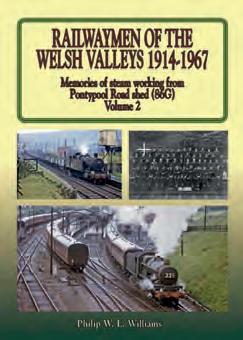Déjàvu?
onlyrealisticsource.TheGreatWestern Railway,forinstance,hadonlyone operationaldieselshunterat nationalisation.Inanyeventthe350hp dieselelectricwasnomatchforapannier tank(traditionallyalsousefulforpassenger andgoods,branchesandsoon,aswellas shunting)atspeedsabovewalkingpace.For thissortofworkadiesellocomotiveof 750to1,000hpwouldberequiredasthe speedreachedthe35to50mphbandandit wouldbenecessarytoprovidesteam heatingforthetrain.In1947thiswasquite simplyunimaginable.
Attheendofthewarin1945arounda thirdoftheGreatWestern’s4,000-odd locomotiveswere0-6-0tanks,themajority ofthemtherelativelymodern57XXclass anditsderivatives,datingfrom1929 onwards.However,thisleftsome600 decidedlyantiqueArmstrong,Deanand miscellaneousabsorbedenginesfromthe pre-groupingWelshconstituents. Objectively,therewaseveryscopeforthe replacementofthesesixhundredelderly locomotives;theywereallintheshunting andmediummixedtrafficcategorieswhich couldbeadequatelycoveredbypanniertanks orthe2251Collettgoodstenderengine. Withaslowdownonreplacementduring wartimethesubsequentrequestfromthe
RunningSuperintendentforlarge quantitiesofnewpanniertankswasthus perfectlyexplicable.Ifanerrorof judgementwasmadeatallitwasperhaps whentheGreatWestern’sGeneralManager insistedthatsomething‘moremodern’ thanthe57XXshouldbebuilt.
The94XXwas,inreality,asmaller wheeledversionofthe2251tenderengine withtanksandbunkersubstitutedforthe tender.lnfact,thetimingsuggeststhatthe tenSwindonbuiltprototypeexamples utilisedpartsalreadyinexistenceforabatch of2251s.Mostofthewearingpartsand longleaditemslikecylinders,motionparts, connectingandcouplingrods,boilersand soonwerethesameforthe2251andthe new94XXlocomotives.Theycouldeasily havebeenborrowedfromtheformer,and laterreplacedbypartsmadeforthelatter, toproducethetenpanniertanksinthe shortesttimepossible.Itseemsverylikely thatHawksworthwassimplybeing cautiousinorderingapilotbatchoften 94XXlocomotivesforevaluation,before embarkingonalongproductionrun.
Whenthe94XXswereauthorisedthere was,despiteperceptionstodaytothe contrary,nouniversalappreciationthat nationalisationwould,infact,cometopass. Thefirstintimation,otherthananything
5 7.WesternRegion0-6-0sD9500-D9555
The‘A’-endofD9509,thetenthlocomotiveontheproductionline,part-waythroughconstructioninSwindonWorksfamous ‘A’-Shopinmid-1964.Theframeworkforthelightweightsteelbonnetshasbeenfixedandtheradiatorandenginearein place,andthecabhasalreadybeenfabricated.Rail-Online
Withthebonnetsnowcompleteandthecabfitted,D9500wasnearingcompletioninSwindonWorkson31May1964.Itwas readyforitspressphotographsfourweekslaterbutdidnotofficiallyenterserviceuntil24July.

containedintheLabourPartymanifesto, ofthenationalisationoftransportcamein theHouseofCommonsinNovember 1946,welloverayearaftertheelection.Even thenitwasfeltthata‘considerabletime’ wouldelapsebeforetheplanscouldbe implemented.Thefulltextofthe TransportBillwasmadeknownon28 November1946andRoyalAssentcameon 6August1947.Bythistimeallten locomotivesofthepilotbatchof94XX panniershadbeenplacedinservice.
Nationalisationoftherailwayswould followsoonafterwards,anditprobably occurredtoSwindonthatifnoorderswere placedbeforetheendof1947,thenitmight beyearsbeforeanymorenewlocomotives becameavailable.Therefore,theGWR electedforaverysensibleactioninthetime availabletoit.‘Sensingaperiodof organisationalvacuum’theopportunity wasdulygraspedandordersplacedwith thelocomotivemanufacturing“trade”for twohundred94XXpanniertanks,andall thepurchasingwascompletedbefore nationalisation.TheInvitationstoTender wereissuedearlyin1947andthebids receivedbackinJune.BasedontheHunslet internalworkscopyorderdated7February 1948forthelastofthe94XXbuilditis reasonabletosaythatall200locomotives
werethesubjectoffirmcommittedorders withinfiveweeksofnationalisation.The newBritishTransportCommission’s involvementhadbeenminimal-ifthat. Thiswasthekeypoint;therewasno turningbackbyanyofthepartiesmanufacturersorpurchaser-without seriousfinancialloss.Thewholeprogram hadbeenstructuredtogivewhatwasby nowtheWesternRegionitstwohundred 94XXpanniertanks withinatimespan ofthreeyearsorso
Atthattimetheminimumdelivery periodwhichcouldbeexpectedonany locomotivewas24to30monthsfrom acceptanceoforderandthenatarateof twoorthreepermonthdependantonthe sizeofthemanufacturerandtheirother commitments.Ifthisdeliveryprogramme hadbeenachievedthenall200wouldhave beeninservicebythemiddleof1952,long beforeanyseriousthoughtsofwidespread dieselisationwerebeingentertainedand beforebuscompetitionhadbeguntobite intolocalservicesintheWelshValleysand elsewhere.DoctorBeeching,ErnestMarples andmotorwayswereadecadeaway.The railwayswerethemassivecommoncarriers theyhadalwaysbeen.
Unfortunately,theplansoonbeganto fallapart,foravarietyofinterconnected
reasons.Mostoftheprivatebuildershad exportorderswhichhadbeenunfulfilled duetotheinterventionofthewar;other orders,bothhomeandexport,werebeing placedatarapidrateandtherewasa continuingworkloadofrepairs.Steelwas inshortsupplyandproductionneededto besteppedup.Thesteelmakingprocesses ofthedayrequiredcoal,lotsofit,andcoal reliedontherailwaysforitsmovement. Coalwasthefirstiteminthesupplychain andtheGovernmentlookeduponthisas apriorityindustry.Therailwayprivate manufacturerswereover-committed,an inevitableconsequenceoffivewaryearsand thesubsequentbacklogofnew construction.
On15November1948theWestern RegionwrotetotheLocomotive ManufacturersAssociationadvisingthatthe Governmenthadreducedthesteel allocationtoBritishRailwaysand,asa consequence,therateofdeliveryofnew locomotiveswastobeslowed.TheLMA tookupthematterwiththeMinistryof Supplywhoadvisedthatthisrestriction appliedtoallBRlocomotiveswhetherbuilt inBR’sownshopsorbyoutside contractors.AyearlatertheLMAwasagain advisingitsmembersofafurther requirementfromthecustomertoslow
6 DieselDawn
deliveries.ThenotesaidthatMrRiddles oftheRailwayExecutivewasaskingtobe advisedoftheextentbywhichdeliveries plannedfor1950couldbereducedasthe RailwayExecutivewerebeinginstructedto cutconsiderablytheircapitalexpenditure. Thiswasbecauseofthenationalnecessity toreducecapitalexpenditureandthe suggestionwasmadethat“asthe association”(i.e.theLMA)“isengagedin vitalexportbusinessMembersmay welcomesomereliefinthedemandsupon themfromtheRailwayExecutive”.
Thereisnodoubtthat(withoutthese tworequestsfordelayeddelivery)mostof themanufacturerswouldhavebeenina mess.From1950onwardstheWestern Regionwascompletelyinthehandsofthe manufacturersregardingdeliveryandthe manufacturerswere,inturn,tiedinto contractualobligationswithother customers.Correspondencewaspoliteand, whilstexpressingdisappointment,all Swindoncoulddowasrelyonthe suppliers’“bestendeavours”.
ThecontractssignedbytheGWR includedastatementtotheeffectthatall priceswerebasedoncostsrulingatthedate oftender(i.e.June1947)and weresubject toadjustmentoncompletion intheevent ofalterationstocostsofmaterials,wages, hours,workingconditionsoranyother changes.Therightwasreservedtomake appropriateadjustmentstotheinvoice at thetimeofdelivery.Thus,thefinal invoiceforthelastenginedeliveredin October1956showedacostvariation(ie increase)of£4,204,almost50%abovethe initialcontractpriceof£8,720.This apparentprofligacywithtaxpayermoney wassolelydowntotheoriginalcontract termsandthelatedeliveryandwasnotthe faultofthe1950sWesternRegion management.
Bytheendof1956,BritishRailwayshad alreadybuiltaroundthreehundredofthe standard(laterClass08)dieselshuntersand manyofthe94XXwentintostore,with withdrawalscommencingin1959.They wereperceivedbymanycommentatorsasa wasteof(taxpayer)money,buttherewas actuallynothingthatcouldbedoneonce theGWRhadinitiatedtheirpurchasein 1947.
NowfortheD95XX…
On15February1957theWesternRegion AreaBoardpresentedtotheBritish TransportCommissionChairman’s ConferenceonModernisationits dieselisationplanwhichincluded368 locomotivesof800bhpoutofatotal requirementof1,425units;thisplanwas tobecompletedinfourstages,byarea, between1959and1968–seetable,top.86 ofthelower-poweredType1locomotives wereincludedinStages1and2,for completionin1959and1960respectively, butsincenoType1designwasthen availableType2sweretemporarily substituted.Thiswaslessthansixmonths afterthelast94XXwasdeliveredwhich impliedthatalloftheseengineswouldbe withdrawnwithinthenextdecadeorso. However,thiswasonlyoneexampleof therushbyBritishRailwaystoeliminate steamwhichwouldprovesocostly.
ElevenType1swereputforwardinMay 1960forthethirdareaandafterminor changestwelve660bhpmachineswere authorisedinFebruary1961atacostof £36,000each(significantlybelowthe1960 estimateof£58,000);inaddition,44Type 1swerecarriedforwardfromthefirsttwo areaschemes,makingatotalof56 locomotives.Allwouldhavehydraulic transmission,thedebateondiesel-hydraulic versusdiesel-electrictransmissionhaving notbeencompletedbythisdatealthough itwasalreadyclearwhichwouldemergeas thevictor.TheirdesignfollowedtheBritish TransportCommissionTechnical Committeerecommendationdated8 January1960whichstatedthatfutureType 1locomotivesshouldhaveasingle,high cabandlowbonnetstoallowgoodvisibility inbothforwardandreverseoperation.
TheWesternRegionjustifiedits decisiontooptforwhatwasarelatively low-powereddesignonanumberof points:
-Thelocomotiveswouldbeneeded mainlyfortripfreightandassociated shuntingwork
-TheexistingNorthBritishType2was double-ended,andnotsuitablefor shuntingdutiesandwasover-poweredand tooexpensiveforthework
-Thestandard350bhpshunterwasnot powerfulenoughanditsmaximumspeed toolowformain-linetripwork
-TheType1900bhpdiesel-electricdesign (whichemergedastheD8500Clayton)was alsomoreexpensiveat£50,000eachand thereforethe660bhphydraulic,whichwas notequippedfortrainheating,wouldsave around£15,000perunit.
TheTechnicalCommitteeMeetingon 23September1961approvedtheproposal (whichwouldsavearound£6millionif thenumberrequiredwasaroundthe400 unitsenvisagedbytheWesternRegion). FinalBritishTransportCommission approvaldidnotcomeuntilJanuary1962 whenitwasagreedthattendersberequested tocompletethefirstthreeWRArea schemes,includingthenow56660bhp Type1s.
Thefollowingmonth,theSupply CommitteeMeetingrecommendedthatthe first26locomotivesshouldbebuiltat SwindonWorksunderLot456,fillingthe gapcausedbythetransferoftheproduction oftenWesternClass2,700bhplocomotives toCreweWorks,andtendersbeinvitedfor theremaindersinceatthatdateitwas envisagedthatnomorelocomotiveswere tobebuiltatSwindon.Theestimatedcost was£34,520each,ofwhichtheenginesto besuppliedbyDaveyPaxman&Co.Ltd wouldaccountfor£7,550andthe transmissionsfromVoithinGermany another£6,400.
Contractsfortheremainingthirty locomotivesunderLot500wereagreedin early1963forthetransmissionsat£5,584 eachwithVoithEngineeringLtdintheUK andwithPaxmanfortheenginesat£7,954 each.Inanaboutturn,thesewerealsoto bebuiltatSwindonatanestimatedunit costof£35,429,whichwasbelowthe lowesttradepriceofferof£37,250from Beyer,Peacock&Co.Aswithallrailwayinhouse“costs”,whatwentintothequoted figurewasverymuchtheproductofan accountancyartform,andwasnotdirectly comparablewithanactualpurchaseprice fromanexternalsupplier.
However,aswiththe94XX,theType1 storywasthenovertakenbyeventswith thepublicationinMarch1963ofthe ‘BeechingPlan’whichatastrokeaborted theideaofanymoreWesternRegionType 1ssincetripworkingwouldbeeliminated asquicklyaspossiblebecausefreightservices wouldberationalisedandfocussedon blocktrainloads.Thus,boththe94XX
7
7.WesternRegion0-6-0sD9500-D9555
AreaCovering Plannedcompletion (2/57) Type1s included Revised 6/59 Revised 2/61 Revised 12/61 1WestofEngland 1959 24 949444 2Bristol 1960 62 3GloucesterandSouthWales 1965 182 1212 4/5London,BirminghamandChester 1968 100 368 56
D9500posedforitsofficialportraitson25June1964.ThedieselequivalentoftheGWRpanniertankwithitsspokedwheels andcouplingrods.Thebasicequipmentlayoutoftheselocomotivesinvolvedacentraldrivingcab,withtheforwardnose compartmenthousingtheengine,coolingequipmentandexhausters,whilstintherearhoodsectionwerethetransmission, auxiliarygenerator,andcompressor.The4ft.0in.diameterwheelshadcaststeelcentreswithpressed-ontyres,andbalance weightscoveringthreeofthetwelvespokes.Thenon-flutedcouplingrodswerejointedattheflycrankandintermediateaxle positions.Initially,therewereshroudeddouble-claspbrakeblocksatthe‘A’-endsideofallsixwheels.

andtheD95XXweredeliveredindifferent circumstancesthanwhentheywerefirst conceivedandordered.Inthediesel’scase, however,themoneywastedwasmuch morevisiblethanwiththe94XXinthe 1950sasthefollowingsection demonstrates.Firstly,therewasthealmost inevitablecostover-run–seeuppertableat right.Thefinalreported“cost”ofthe locomotivescameinatover20%morethan forecastat£42,357each,amountingtoan over-spendofaround£412,000.(Intoday’s money,usingtheBankofEngland’s inflationindexforGoodsandServices,this equatestoaround£5.6million).The Swindonfiguresareinthelowertableat right.TheBritishRailwaysBoardauthorised
theadditionalexpenditureinFebruary 1966.Itwasprobablynotquiteasbadas appearsatfirstsightsinceasignificant proportion,probably20-25%,of Swindon’s“cost”wasrepresentedbythe
contributiontothefixedoverheadsofthe Workswhichwouldhavebeenincurred irrespectiveoftheconstructionofthe locomotives.
Actual £2,372,000£42,357£677,000
Under-estimatesbeforefinaldesigncompleted240,000 Modificationsneededduringconstruction 32,000 Priceinflationsinceoriginalestimatesmade116,000 Designchanges
TechnicallySpeaking
Theleadingparticularsopposite suggestthattheD95XXwas, perhaps,Swindon’sdiesel-hydraulic developmentoftheirbelovedpannier tanks!
Theunderframewasconventional,with twoheavymainplateframes1¼in.thick
and30ft.6in.long,stayedwithvertical andhorizontalstretchersandcarrying outriggerstosupportthefull-widthcab, sidefueltanksandbatteryboxes.The15ft. 6inwheelbase,unevenlyspacedat6ft.6in. and9ft.0in.wasthesameintotalasthe 94XXpanniers,althoughthesewerespaced
at7ft.3inand8ft.3in.Deepbufferbeamswereprovided,5in.thickatthe‘A’ endand1½in.thickatthe‘B’end,which ensuredanevendistributionofweighton thecoupledwheels.Independent laminatedspringsboredirectlyontoinside Timkenrollerbearingcast-steelaxleboxes,
8 DieselDawn
£
24,000 £412,000
Buildingcosts Totalfor56 locomotives Eachat1964 prices Eachat2022 prices Originalauthorised£1,960,390£35,007£560,000
Leadingparticulars
Lengthoverbuffers
Weightinworkingorder
D95XX94XX0-6-0PT

34ft7in33ft2in
50tons55tons7cwt.
Wheeldiameter 4ft0in4ft7½in
Wheelbase 15ft6in15ft6in
Max.tractiveeffortat27.6percentadhesion/85%30,910Ib.22,515Ib.
Fuelcapacity 338gallons
Axleloading 17tons19tons5cwt.
Maximumservicespeed 40m.p.h.
Maximumwidthoverall 8ft7-9/16in8ft.7in.
Minimumcurvenegotiable 4½chains
whichraninmanganesesteel-faced,cast steelhornblocks.
The4ft.0in.diameterspokedwheels hadcaststeelcentreswithpressed-ontyres, andbalanceweightscoveringthreeofthe twelvespokesoneachwheel.Theflycrank wasfastenedtotheprojectingendsofthe jackshaftandhada10in.throw.Thenonflutedsteelcouplingrodswerejointedat theflycrankandintermediateaxle positions.
One(longer)bonnetatthe‘A’-end housedtheengineandcoolergroupand theotheratthe‘B’-endthehydraulic transmissionandbrakeequipmentframe. Thefuelcapacitywas338gallons,carriedin threetanksatthe‘A’-end,oneoneachside oftherunningplateinfrontofthecab andthethirdmountedbetweentheframes
toevenlydistributetheweightandavoid unduechangesintheweightdistribution duringaccelerationandbrakingorwhen workingonsteepgradients.Shorterboxes withhingedchequerplatelids,ateachside ofthefootplatebehindthecabatthe‘B’end,eachhousedtwo24cellCromptonParkinsonbatteries.Thebonnetswereof simplelightgaugesheetsteelconstruction, withthefullwidthdrivingcabinsulated thermally,andfromenginenoise.Access totheequipmentwasthroughhinged doors,fourtoeachsideatthe‘A’-endand threetoeachsideatthe‘B’-end,and throughsealedremovableroofcovers fittedwithventilators;hingednosedoors werealsoprovided.Atthe‘A’-end,fixed radiatorlouvreswerepositionedoneither side,withacirculargrilleintheroofforthe
air-intakefan.Twintrainheadcodeboxes wereprovidedatbothends,withone doubledigitboxinthebackofeachnose accessdoor.
Thespacioussound-anddraughtproofedcabtaperedinwardsfromthelower edgeoftheslidingsidewindowstothe endprofilesofthehighroof.Therewere twolargewindowsineachbulkhead, contouredtofollowtheroofprofileand theuppermostcornersofthebonnets,and thecabdoorswerefittedwithdroplights. Airoperatedwindscreenwiperswerefitted andthereweretwo-toneDesiluxair warninghornsontopofthebonnetsin frontofthecab.Atthe‘A’-end,thesewere fixedinfrontoftheengineexhauststack, thatwasitselfattachedcentrallytothe outsideoftheforwardcabbulkhead.
Therewereduplicatedrivingpositions, oneforeachdirectionoftravelandthe electricalcontrolcubiclewaspositioned againsttheforwardbulkhead,withthe Driver’sdesk,seatandSecondman’s positionsagainsttherearbulkhead.
PowercamefromaPaxmanVentura 6YJXdieselenginefittedwithaNapier exhaustgas-driven,water-cooledturboblower.Thissix-cylinderveeenginehada maximumcontinuoustractionratingof 650hpat1,500r.p.m.Theenginewas flexiblysupportedonfourMetalastik mountingsandthedrivetothe
9 7.WesternRegion0-6-0sD9500-D9555
D9544nexttoD0280FALCONinSwindonWorksduringMay1965,shortlybeforeitwentintoserviceattheendofthe month.Thecabtaperedinwardsfromtheloweredgeoftheslidingsidewindowstothegutterlineoftheroof.Thelarge windowswhichgaveexcellentvisibilitytothecrewwerecontouredtofollowtheroofprofileandtheuppermostcornersof thebonnets.Notethecontinuousupperhandrailswhichranalongthetopedgesofthebonnets.Rail-Online
TheofficialfrontendviewofD9500 showstheshunterstyleblack/yellow chevrons,yellowbufferbeamsandbuffer housings.However,sincetheClasswould workonthemainline,twintrain headcodeboxeswereprovidedatthe frontandrear,withatwo-digitbox housedineachaccessdoor.Thereis onlyabrakepipeonthebufferbeam becausetherewasnotrainheatingor multipleworkingequipment.Theflat metalstriphandrailswhichranalongthe topedgesofthebonnetsonD9500as firstbuiltdidnotpasscompletelyround theends,butstoppedshortatthefront, justaroundtheoutercorners.Itwas quicklymodifiedandalltheotherswere builtwithacontinuousrail.

transmissionwasthroughaHolsetflexible couplingmountedontheflywheelanda HardySpicercardanshaftthatraninatunnel throughthecentreofthecabatfloorlevel, separatingtheDriver’sandSecondman’s positions.Enginestartingwassimilarto thatinacar,bymeansofaCAVnon-axial starter,whichengagedwithteethonthe engineflywheel.
ThehydraulictransmissionwasaVoithNorthBritishTypeL217ucontainingtwo torqueconvertersinserieswithafluid coupling.Thefirstconverterwasusedfor startingandlowspeeds,thesecondfor intermediateandthecouplingforfast speeds;onlyonecircuitwasinuseatatime,
thechangeoverfromonetoanothertaking placeautomaticallywhenthespeedreached thevaluestowhichthetransmission governorwasset.
AHunslettriplereductionandreverse gearboxwasbolteddirectlytothemain framessothatthecaststeeljackshaft bearinghousingwasmidwaybetweenthe intermediateandtrailingwheelcentres. Reversingmechanismwasincorporatedin thesecondreductionstage,air-actuatedby adouble-actingpneumaticcylindersituated outsidethebox,althoughreversingcould alsobedonemanually.Theradiator,cooling fanandmotor,controller,hydrostatictank andassociatedpipe-workweresuppliedby
10 DieselDawn
Above.
tobeinstalledatSwindonWorksinJuly1964.The lightweight,six-cylinderveeenginehadamaximum continuoustractionratingof650hpat1,500r.p.m. TheywerefittedwithaNapierexhaustgas-driven, water-cooledturbo-blower.Theenginewasquite compactinsize,63¼in.longby55¾in.wideand 56in.high.


SerckRadiatorsLtd.asacompleteunit,andtheSerckBehrsystemforcontrolofthefanspeedwasemployed. APlesseyhydraulicpumpwasmounteddirectlyonthe engineandsuppliedoilunderpressurethrougha controllerwithathermostaticvalvelocatedintheengine coolingwatersystem,tothefanmotor.Variationinthe coolingwatertemperaturevariedtheoilpressuretothe fanmotorandhencethespeedofthefan.
AWestinghousevacuum-controlledairbrakesystem wasfittedwithtwomotor-drivenrotaryexhaustersto producethevacuumforthetrainbrakes.Thedriver’s vacuumbrakevalveappliedthetrainbrakeswhen vacuum-brakedstockwasbeinghauledandatthesame timeaproportionalapplicationofthelocomotiveairbrakewasmade.Adriver’sair-brakevalveallowedthe locomotivebrakeonlytobeapplied.Apassenger/goods valvesloweddowntheproportionalbrakeapplication
therearbulkhead.
11 7.WesternRegion0-6-0sD9500-D9555
APaxmanVentura6YJXdieselengineready
8 7
Left. Thespacioussound-anddraught-proofedcab hadduplicatedrivingpositions,oneforeachdirection oftravelandtheelectricalcontrolcubiclewas positionedagainsttheforwardbulkhead,withthe Driver’sdesk,seatandSecondman’spositionsagainst
whenswitchedtothe“goods”position.A driver’ssafetydeviceprovidedforthe applicationoflocomotiveandtrainbrakes ifafootswitchatthedrivingpositionora push-buttonintheendofthecontroller handlewasreleased.Initially,therewere shroudeddouble-claspbrakeshoesatthe ‘A’-endofallsixwheelsbut,afterextensive trialswithD9517followingcasesoftyre overheatingandcracking,theywerechanged tounshroudedsingleblocks,probably fromD9549onwards;earlierlocomotives
weresoonmodifiedunderMB442/23.Air assistedsandingwasprovided,withthe sandpipesfeedinginfrontoftheleading coupledwheelsandbehindthetrailing wheels,thesandboxesbeingfittedtothe outsideoftheframes.
Dieselshunter-styleshunters’steps,built upfromsteelplate,wereprovidedatthe frontandrearwithathirdsetofstrap-type stepsgivingaccesstothecab.Therewas wiremeshbehindthecabstepstoprevent contactwiththeflycranks.Thehandrails
whichranalongthetopedgesofthe bonnetswerenotthetraditionalroundbar, butflatmetalstrips;ontheofficial photographsofD9500thesedidnotpass completelyroundtheends,butstopped shortatthefront,justaroundtheouter corners.Howver,whenitenteredservice, therailshadbeenchangedtothe continuouspatternwhichwasfittedtothe remainderoftheclass.
Therewasnoprovisionfortrainheating orformultipleworking.
D9500freshoutoftheshopsshowshowthetwoshadesofgreenset-offbytheyellowendsmadetheD95xxratherpretty littlelocomotives.Thereareshroudeddouble-claspbrakeshoesonallsixwheelsbut,afterextensivetrialswithD9517 followingcasesoftyreoverheatingandcracking,theywerechangedtounshroudedsingleblocksprobablyfromD9549 onwards;earlierlocomotivesweresoonmodified.Sandingwasairassisted,withthesandpipesfeedinginfrontoftheleading coupledwheelsandbehindthetrailingwheels;thesandboxeswerefittedtotheoutsideoftheframes.J.Cramp/ColourRail

LiveryandStyling
DesignConsultantsAllen-Bowden Ltdwereusedtoadviseon detailingwithGeorgeWilliams, BR’sDirectorofIndustrialDesign,saying thattherewouldbesimilarproblemsto thoserecentlyencounteredwiththeClayton Type1diesel-electric.Williamsalsoputa capontheirworkat£600comparedtothe £610theyhadquoted!Allen-Bowden’sfirst inputwastosuggestthat“holesmightbe providedinsteadofthetraditionalsteps” andthattheywouldadviseonthecolour scheme.Next,theytookexceptiontothe amountof“louvringneededinthebonnet
accessdoors”whichtheythoughtwas “ratherseriousfromtheIndustrialDesign pointofview”andthensaidthattheair cowlsonthetopofthebonnets“look totallyoutofplace”.Minorchangestothe louvresweretheonlyconcessionagreedby Swindon.Infact,thedesignwaspretty muchcompletebythetimeAllen-Bowden cameontothesceneandcostconstraints weretootightforanysignificantchanges.
Attentionthenturnedtotheliveryand theconsultants’proposaltouseabase liveryofanythingotherthanthestandard locomotivegreenwasswiftlyvetoedby
GeorgeWilliams,aswastheirsuggestion touseClass52Westernstylecast numberplates.Allen-Bowdencameback withtheideathatthecabsidesshouldbe ina(lighter)SherwoodGreenwiththe bufferbeamsinyellow,bothofwhichwere takenforward;theyalsothoughtthelower handrailsshouldbewhite-thiswasinitially rejectedasimpracticalsincetheywould becomedirtyafterafewdaysinservicebut wassubsequentlyimplementedandallthe handrailswerewhite.
Thus,whenD9500emergedfrom Swindon,itwasinanattractivetwo-tone
12 DieselDawn


















